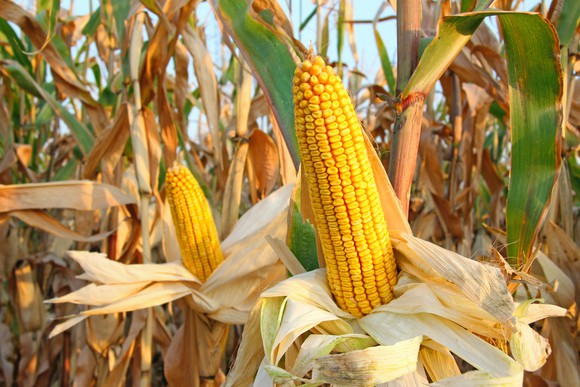
A bumper crop of corn, wheat, and soybean because an expected weather pattern failed to materialize could impact farmer fertilizer needs. Image source: Getty Images.
Despite all three major North American fertilizer producers agreeing that the potash market has hit bottom, you still shouldn’t believe them. The market remains in oversupply, producers are still producing more than they sell, and PotashCorp ‘s(NYSE: POT) big dividend cut indicates that it is hedging its bets.
Diminished expectations
PotashCorp got the ball rolling by reporting second-quarter results that, although they met analysts’ expectations for profits, missed on revenues, and the company was forced once again to lower its outlook for the year. That amounts to the fifth time in the past six quarters PotashCorp had to reduce its guidance — hardly a track record to engender confidence that the market was about to make a U-turn.
Yet Mosaic (NYSE: MOS) followed PotashCorp with its own dismal results as sales tumbled 32%, while a year-ago profit of $ 391 million became a $ 10 million net loss this time around. Surprisingly, Mosaic, too, said happy days would soon be here again and saw “signs of stabilization in the second half of the year.”
Not to be outdone, Agrium (NYSE: AGU) joined the parade, jumping on the bandwagon with lower profits and a reduced full-year outlook. And like PotashCorp and Mosaic before it, the crop nutrient producer also had reasons for hope:
- End users were depleting their inventories by being so careful with them.
- Seasonal growth in deliveries should work in its favor.
- There was no more capacity coming online in the near future, and global capacity was down more than 2% from 2014.
- Greater market certainty returned after India and China signed supply agreements, albeit at dramatically lower prices.
China’s slow boat to sail on by
Earlier in the year, PotashCorp had pointed at historical trends indicating 2017 would be a better year. It noted that in years following delays in China’s signing contracts (or not signing one at all), higher demand invariably followed.
That may be true, but just as in investing, past performance is not a guarantee of future results. Analysts at Credit Suisse say the chances of a potash rebound as predicted by the three major producers are little more than wishful thinking, and that higher prices “will elude us for years, not quarters.”
Financial analysts anticipate potash prices of $ 200 per tonne next year and $ 190 per tonne the year after, and that’s after India signed a contract for this year at $ 227 per tonne, and China followed with one for $ 219 per tonne. However, Credit Suisse had expected the latter to sign a contract for no more than $ 210 per tonne.
Complaining about the weather
Some of the upbeat outlooks were predicated on currencies in Latin America stabilizing and the global La Nina weather pattern positively impacting crop plantings here at home. The analysts say that while currencies in Brazil and elsewhere may have stabilized, credit remains an issue there, as does demand.
Similarly, La Nina hasn’t materialized, and U.S. farmers are inundated with a bumper crop. The Financial Times reports wheat, corn, and soybean crops have come in at overflowing rates, with farmers anecdotally reporting unprecedented harvests. As a result, crop future prices are plunging as even other markets such as Russia, the Ukraine, and Europe all report better outlooks.
While PotashCorp is putting on a brave front, it’s also preparing for an extended downturn — otherwise why slash its dividend 60%, having already cut it once before this year? CEO Jochen Tilk admitted as much, noting on the call with analysts that “despite recent evidence that prices have stabilized, we intend to take the prudent approach to protect our balance sheet.”
It’s quite possible that future potash pricing might not remain near their lows for the rest of the year, but there remains enough doubt and macroeconomic headwinds that investors might want to be circumspect about the feel-good attitude being expressed by these potash producers before planting a stake in their stocks.
A secret billion-dollar stock opportunity
The world’s biggest tech company forgot to show you something, but a few Wall Street analysts and the Fool didn’t miss a beat: There’s a small company that’s powering their brand-new gadgets and the coming revolution in technology. And we think its stock price has nearly unlimited room to run for early, in-the-know investors! To be one of them, just click here .
Rich Duprey has no position in any stocks mentioned. The Motley Fool has no position in any of the stocks mentioned. Try any of our Foolish newsletter services free for 30 days . We Fools may not all hold the same opinions, but we all believe that considering a diverse range of insights makes us better investors. The Motley Fool has a disclosure policy .
The views and opinions expressed herein are the views and opinions of the author and do not necessarily reflect those of Nasdaq, Inc.
Plantations International